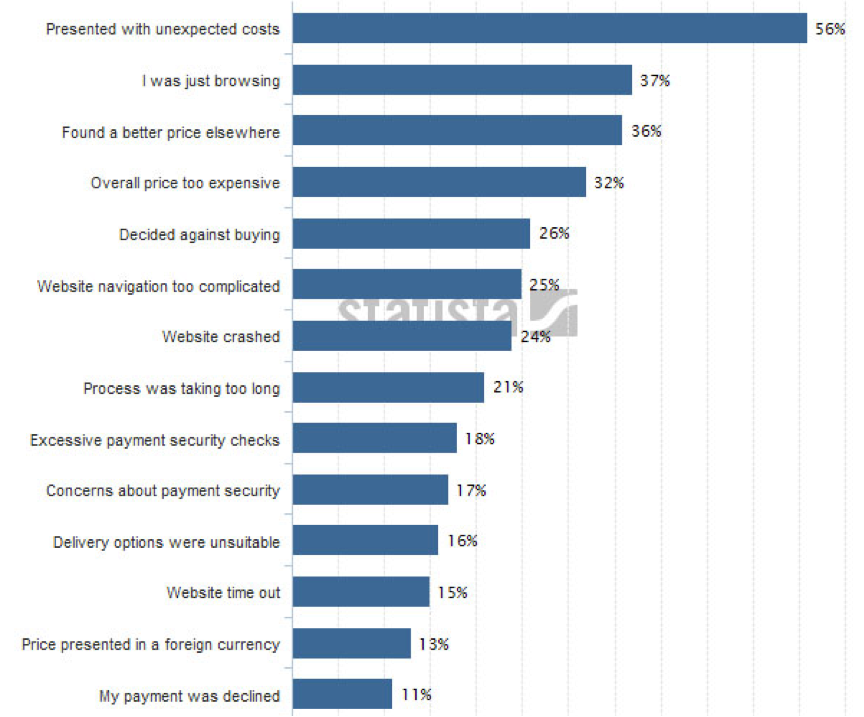For many eCommerce stores, shopping cart abandonment is a a common issue. If you are an eCommerce merchant, reading this article can help you solving the problems about the shopping cart development and making your eCommerce a big change. Don’t ignore the situation, or you will run the risk of missing out a potential new or returning customers. Follow the necessary steps to prevent shopping cart abandonment and guide shoppers to complete the sale.
Clearly shopping cart abandonment is a big problem. Now we’ll look at why. According to Statistia there are 14 main reasons why shoppers abandon their carts.
We will give you a walk through as to why shopping cart abandonment occurs, how to approach customers who have abandoned their carts, and tips on how to continue building relationships.
The first step to recovering abandoned shopping carts is to discover the reasons that your customers abandoned their carts in the first place. Here are some reasons below for shopping cart abandonment.
Reason 1: Distracting Design
The most common reason for mobile shopping cart abandonment is distracting, overwhelming design.
Mobile shoppers can be very impatient and are mostly focused on completing the action at hand. So once your customers are ready to buy, the best thing you can do is get out of their way.
This is why you need to remove all obstacles on your customers’ path through the checkout process, both visually and functionally.
Reason 2: Annoyed at Complicated Checkout Process
The checkout process needs to be as simple, smooth and quick as possible. If you make the user fill out too many forms or perform too many complicated or repetitive actions, the impatient customer will abandon the cart and leave.
Touch keyboards are almost impossible to navigate blindly and require switching back and forth between text and number layouts. You can ease your shoppers’ pain and improve your mobile conversion rates at the same time by asking for only the necessary information.
In most cases, all you need is confirmation that the right items in the right quantity are being purchased, then billing details and shipping info, and that’s it. This is not a good time to interrupt a user’s process with a survey or anything else non-critical.
Reason 3: Forced to Register and Create an Account
It’s great to offer users the ability to create an account with your site. On the other hand, forcing them to do so is a bad idea that will cause your conversion rates to drop drastically. The more information you have about a client, the better you can market – and deliver – your products to them. A registered user is more likely to visit the site again and develop loyalty.
Reason 4: Unpredictable Checkout Flow
An unpredictable shopping cart is an abandoned one. It creates too much anxiety in any shopper, especially if she’s on the go.
Splitting up the checkout process into multiple steps usually improves the user experience. It makes the process less overwhelming for the buyer and allows you to save parts of the entered information in case something goes wrong.
However, a new concern may be introduced if steps in the conversion path aren’t labeled well and the calls to action are unclear.
Reason 5: Unsure of Security Features
The thing about many mobile users is that they still perceive buying on mobile as a less safe option than desktop. It may have something to do with shopping in public, or the wireless connection. 17% of consumers indicated concerns about payment safety as the reason for cart abandonment. On the other hand, 18% of them pointed out excessive payment security checks as well. 35% of online stores don’t display any security information throughout the checkout process, raising some legitimate concerns for their customers.
Most people are comfortable shopping on large and popular eCommerce websites, but when it comes to smaller, lesser known websites, they are afraid of phishing and other fraudulent activities. Many users bring their online shopping expedition to an abrupt end if they become unsure of the security features of an ecommerce store.
Use trust seals and security assurance messaging in your checkout flow, particularly on the billing pages. You may even want to experiment with a mobile-specific message to see how that affect conversion.
Pinpointing the reasons that customers are abandoning their carts will help you employ the proper abandoned cart recovery strategies to guide your customers to complete a transaction. Each abandoned cart scenario should be approached differently to effectively push your customers down the sales funnel.
Overall, although customers dropping their carts in the middle of the shopping process is a worrying issue for most online businesses, one of the main reasons for that is simple: most consumers are not willing to buy at their first visit. That’s why the cart abandonment rate can hardly ever be lower than around 50%. For returning visitors though, you have to ensure that the whole course of shopping is as enjoyable, clear, and brief as possible. If you do that, you should expect the cart abandonment rate decreasing in no time.
More details please refer to: Shopping cart development & custom website development

